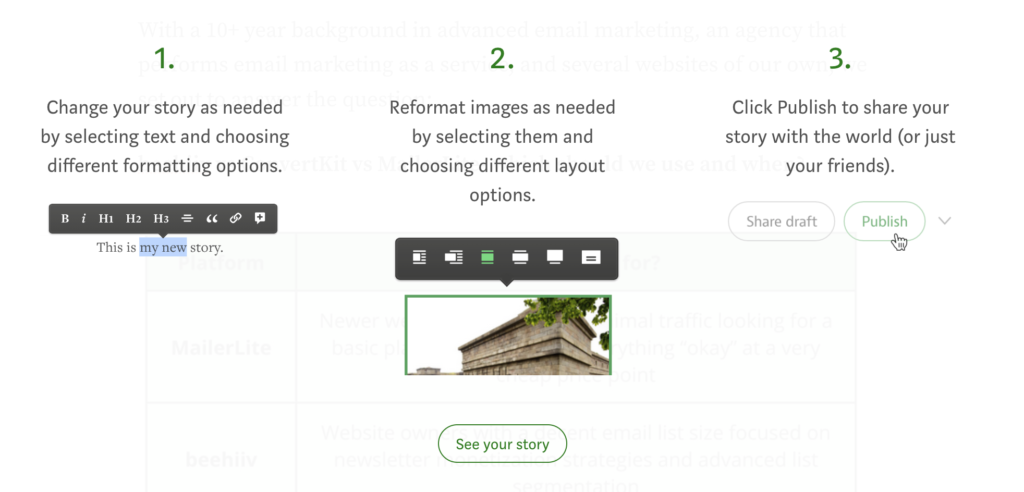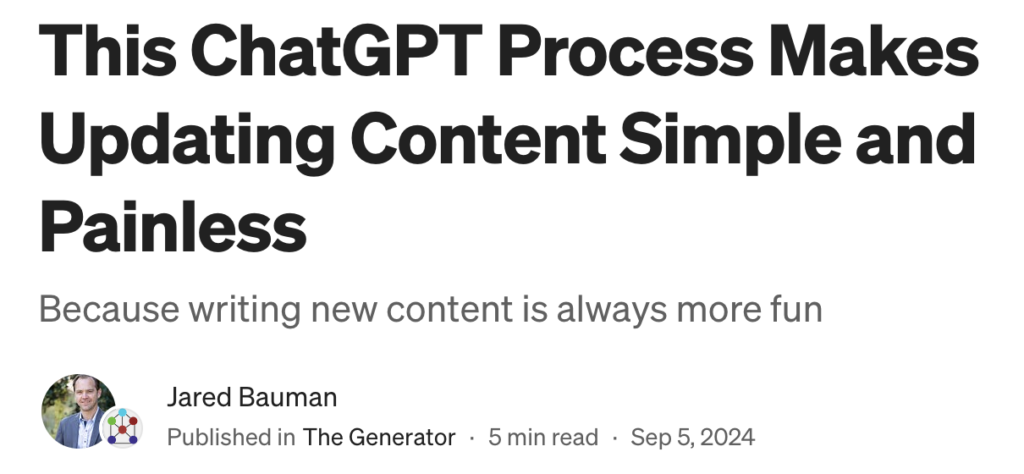I recently shared my step-by-step process for earning over $100 my first few days using Medium. Today, I’m sharing my step-by-step process for importing my content into Medium, and how I adapt it to fit the platform.
My articles on Weekend Growth take a little bit of modification so that they’re ready for the Medium platform.
I provide you with a real world example from this article that I published back awhile ago –> converted to an article that went live on Medium.
Don’t miss out! I’ll be diving deep into my journey on Medium—sharing every lesson, tip, and strategy I pick up along the way. If you want exclusive updates and actionable insights delivered straight to your inbox, join my newsletter now. Be the first to know what’s working and how you can apply it to grow your own traffic!
Quick Navigation
How to Repurpose Your Content on Medium with One Click
Getting your already-published content over to Medium is super simple.
Step 1: Use the Medium Import Tool
To start, head over to the Medium Import Tool here. Yes they make it very easy on you.

Simply paste the URL of the blog post you want to republish. Medium will automatically pull the content over and, most importantly, include a canonical link back to the original post, which is essential for your SEO.
Step 2: Customize Your Content
This is where you can fine-tune your post to make it shine. While Medium imports the text, I recommend taking a few minutes to tweak the formatting. Clean up any formatting issues, and make sure your story flows well on Medium’s platform. You may want to reformat headings, bullet points, and other text styles to suit Medium’s clean, minimalistic design.

Next, add images—this is crucial. Visuals significantly boost engagement on Medium. Even if your original post didn’t have any images, add some now to break up the text and make the content more visually appealing.
I personally love using screenshots with examples.
Step 3: See Your Story & Edit
After importing, click “See your story” to begin editing. Here, you can review your text and add those all-important visuals. Remember, the easier you make it for readers to skim and absorb your content, the better. This is especially true on Medium, where people expect digestible, easy-to-navigate content.
Step 4: Tweak the Post Title & Add SEO-Friendly Tags
Before you hit publish, don’t forget this step—customize your title and permalink for SEO. Make it catchy but optimized for search engines. You can do this by clicking the three dots at the top right corner of the page.
Next, add up to 5 tags. Tags are essential on Medium because they make your post discoverable to readers interested in your topic. Be sure to choose tags that are relevant and popular within your niche.
In summary, here’s your game plan:
- Import your blog post using Medium’s Import Tool.
- Tweak and format your content, and don’t skip the visuals.
- Customize the title, permalink, and add up to 5 tags for discoverability.
- Hit publish and start driving that traffic!
I earned over $100 in my first few days on Medium because I understood the platform and how it worked. I learned this from Thomas Smith’s Thrive on Medium course. He makes $3k-$4k per month on Medium, and his course will give you a head start on earning on Medium.
How to Modify Your Content to Repurpose on Medium
Its easy to import your content into Medium, but I always adapt the content to fit the way Medium articles are best distributed. And I highly recommend doing the same.
Medium has a certain “way” about it, and making sure your content fits this way ensures that it has the best chance to succeed. Here is an outline of exactly how I modify my content for Medium.
As a reminder, here is the original article I published on Weekend Growth, and here is the final, modified version that I published on Medium.
Step 1: Revamping the Title and Headline
- Blog Post Title: “Content Update? Here’s How AI Can Simplify Your Strategy”
- Medium Title: “This ChatGPT Process Makes Updating Content Simple and Painless”
What I Did: The blog post title is clear and SEO-friendly, which works for a structured blog environment. But for Medium, I made the headline more conversational and enticing. I emphasized ease and painless, positioning ChatGPT as a game-changer.
I also was clear that this was a process, appealing to people’s interest in “leveling up” on Medium, as Thomas puts it.

Why I Did It: For Medium, your title should hook the reader quickly. The casual tone of “removes all the research” grabs attention and appeals to the busy content creator who’s likely scrolling through posts.
Step 2: Personalizing the Introduction
- Blog Post Introduction: I jumped straight into a real-world example involving Google’s Danny Sullivan to establish credibility quickly. It was concise and to the point.
- Medium Introduction: I shifted focus to empathize with the reader, opening with a relatable pain point: “Updating content is hard.”
What I Did: For Medium, I reworked the introduction to be more conversational and to connect emotionally with the reader. I still mentioned Danny Sullivan but only after acknowledging the reader’s struggle.

Why I Did It: Medium readers want to feel like they’re having a conversation, not just reading a lesson. By first addressing the challenge that content creators face, I created an immediate emotional connection.
Step 3: Use of Personal Anecdotes and Tone Consistency
- Blog Post: The blog post includes a personal anecdote about your experience with Disneyland’s Genie+ service, featuring the phrase “omg, that whole Genie+ situation is intense.” This adds a casual, relatable element to an otherwise technical explanation, providing a real-world example of how AI can assist with content updates. The anecdote not only demonstrates practicality but also introduces a more conversational tone in the middle of technical content.
- Medium Post: The same anecdote and casual phrasing appear in the Medium article, reinforcing a friendly, approachable tone. Phrases like “omg” keep the piece relatable, making it feel more like a personal story than a formal guide.
What I Did: In essence, I kept these comments. If this particular article hadn’t had any, I would have added one or two.
Why It Matters: This anecdote bridges the gap between providing expertise and keeping the content relatable. In both versions, it ensures readers remain engaged, regardless of whether they’re looking for technical advice or just a more casual read. Consistency in using personal stories builds relatability across platforms.
Step 4: Adjusting the Content Structure
- Blog Post Structure: The blog post was heavily structured with clear headers, sub-sections, and technical instructions, complete with screenshots and links.
- Medium Structure: Medium articles have a very simple layout, so I matched the structure to create a smoother reading experience, reducing technical details and focusing on key takeaways.
What I Did: I streamlined the Medium article to avoid overloading the reader with step-by-step guides. Instead of relying on screenshots and navigation links, I emphasized actionable insights.
Why I Did It: Medium readers tend to prefer content that flows naturally and isn’t bogged down by too many technical details. The simplified structure makes it easier to digest, especially for those reading on mobile.
Step 5: Adapting the Call-to-Action (CTA)
- Blog Post CTA: I had a strong, direct CTA promoting my website review services with clear links.
- Medium CTA: The Medium post focused less on promotion and more on encouraging the reader to commit to updating their content.
What I Did: In the blog post, I pushed my services as a primary CTA. But on Medium, I toned down the self-promotion and instead encouraged the reader to take action on their own content.

Why I Did It: Medium readers typically respond better to value-driven engagement rather than a sales pitch. By focusing on the benefits of updating content, I created a more subtle, organic CTA that aligns with Medium’s culture.
Step 6: Balancing Technicality and Simplicity
- Blog Post: The blog post included more technical details, like specific ChatGPT prompts and detailed screenshots for guidance.
- Medium Post: I reduced the number of technical elements and focused more on broader concepts, while still providing valuable insights.
What I Did: On Medium, I avoided bombarding readers with too much technical information and instead gave a high-level view of how AI can simplify the content update process.
Why I Did It: The goal was to make the Medium article digestible for a wider audience, particularly those who may not be familiar with complex SEO tools or processes.
Step 7: Ending on a Motivational Note
- Blog Post Conclusion: The blog post ended with a formal summary and a promotion for my services.
- Medium Conclusion: I left readers with a friendly reminder to commit to updating their content, providing a softer, more motivational ending.
What I Did: Instead of a hard sales pitch, I concluded the Medium article with an encouraging note, leaving readers inspired to take action on their content updates.

Why I Did It: Medium articles often benefit from a more open-ended, motivational conclusion that keeps the reader engaged, rather than feeling like they’re being “sold” something.
Final Thoughts
Repurposing content for different platforms like Medium is all about adjusting tone, structure, and presentation without losing the core message.
For my blog posts and emails, I’m more technical and formal, while on Medium, my goal is to engage readers with a conversational tone and relatable insights.
To learn more about the Medium platform, tune into my interview with Thomas on the Niche Pursuits podcast.
If you’re interested in fast tracking your success on Medium, grab Thomas’ “Thrive on Medium” course.

